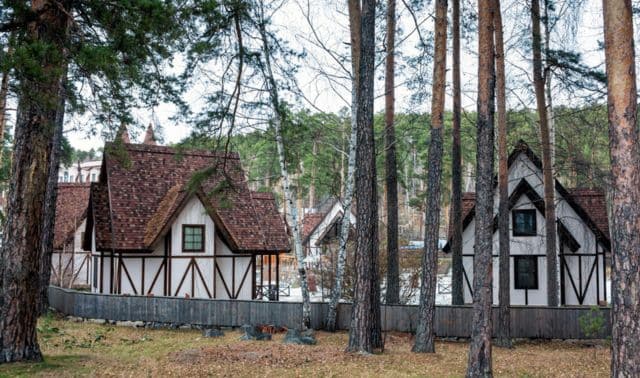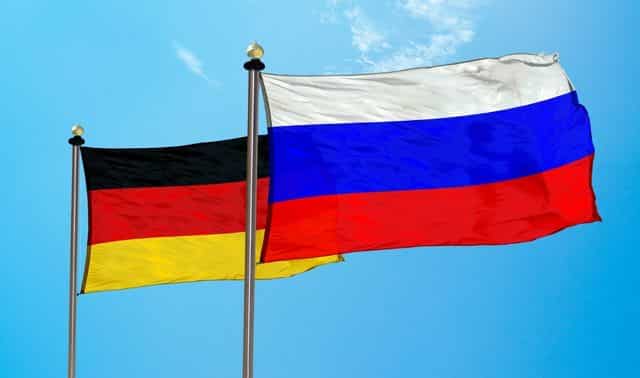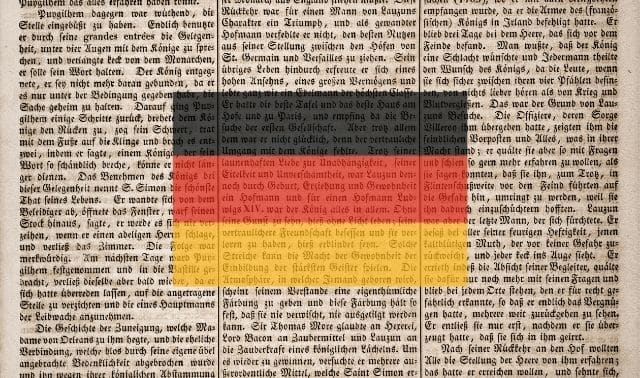Sign up for the Family Tree Newsletter Plus, you’ll receive our 10 Essential Genealogy Research Forms PDF as a special thank you!
Get Your Free Genealogy Forms
"*" indicates required fields

Has your research led you back to das Heimatland? Don’t stop now! From naming patterns to shifting borders, our experts have the answers to your toughest German genealogy research questions.
Jump to:
Finding German Ancestor Origins
Schleswig Holstein Genealogy
Locating Ancestor Records in Pre-WWII Poland
German and Luxembourger House Names
German Military Records Research
Seeking German Army Veterans
German Surnames and Ethnicity
Using German Naming Conventions to Determine Relationships
Researching German Nobility
German Immigrants in the 1870s
German Ancestors Through Staten Island
Finding German Ancestor Origins
Q. Is there any way you can find information about 19th-century German ancestors if you do not know where in Germany they came from?
A. Congratulations on having gotten back to the immigrant generation! Since there is not any centralized German vital records archive or emigration archive, it is not possible to jump directly to German research without knowing where exactly they came from. You need to keep up your search on this side of the ocean in the same sources you have looked at so far—and more.
The place of origin may be found in church records, censuses, passenger lists, naturalization records, death records, obituaries, newspapers, city directories, county histories, family records and many other sources. Especially important for locating Germanic ancestors are German-language church records in America, which may give you a village of origin. Then again, maybe you will have to scrounge to locate the name of your ancestral home.
For instance, if you found a marriage record in America, you might ask:
- Who were the witnesses? Could they be people the couple knew back in the old country? Where did they come from?
- Who performed the ceremony? Was it a clergyman? What congregation was it? Might there be records there? Might there be a published history of the congregation? Maybe even one in German?
If you found an American death record, you might ask yourself the following questions:
- Who was the informant?
- Was there an obituary published in the English-language paper? Was there a more detailed obituary published in the local German-language paper or the regional religious newspaper?
- Where was the person buried? What do the cemetery sexton’s records say? What does the inscription on the tombstone say?
- Who were the survivors?
- What was the deceased’s occupation? A railroad worker, government worker, or corporation worker might be found in governmental or business records.
- Were any lodge or organization memberships mentioned in the obituary? There might be lodge records, such as Sons of Hermann or Schlaraffia, or society memberships, such as the local Männerchor.
- Was the deceased a veteran? Do military pension records or draft records show a place of origin? Those who had to register for World War I drafts included men between ages 18 and 45, whether they eventually went to war or not. (WWI draft registration cards are searchable on Ancestry and browsable on FamilySearch.)
- Were your German-American ancestors aliens during World War I? Aliens had to register too. Some of these records survive.
- Another possibility is passenger arrival lists, some of which give places of origin, or the Hamburg passenger lists (available on Ancestry.com), which give the last place of residence in Europe.
Answer provided by Ernest Thode
Schleswig-Holstein Genealogy
Q. My Danish ancestors were from the Schleswig-Holstein area, which was at times Danish, other times German. Would this influence the location of records for those periods? Might some records be in Germany?
A. You’re correct about the shifting ownership of Schleswig-Holstein. The area’s geographic tensions date to at least the 8th century, when the Danes ruled north of the Eider River and the Franks, to the south. In modern times, the Treaty of Prague in 1866 ceded Schleswig-Holstein to Prussia. Four counties (kreis) in northern Schleswig were returned to Denmark in 1920: Apenrade, Sonderburg, Hadersleben and Tondern. These were then known again by their Danish names, respectively Aabenraa, Sønderborg, Haderslev and Tønder. They were combined into South Jutland County in 1970 and into the Region of Southern Denmark in 2007.
You can search for places once in Germany and now in Denmark, under their German names, using the digital Meyers Gazetteer. This will give you the German county a town belonged to and the names of churches therein.
If you can’t find your Schleswig-Holstein ancestors in Denmark’s excellent church and emigration records, try German sources. For example, local emigrants might not have departed through Copenhagen, and so won’t be in police records of Danish emigration. They may have instead left through Hamburg, Germany.
Resources for Schleswig-Holstein kin in Germany include civil registration indexes and images (1874-1983) at FamilySearch, local chronicles from the holdings of the Schleswig-Holstein State Library (in German) and the Rootdigger website.
Answer provided by David Fryxell
Locating Ancestor Records in Pre-WWII Poland
Q. My husband’s great-great-grandmother was born in Breslau. Would her baptism and marriage records still be with the Catholic churches there, or were they moved?
A. Breslau (now called Wroclaw) is the largest city in a region of Central Europe known as Silesia, called Schlesien in German and Slask in Polish. Prussia conquered Silesia in 1742, and it later became part of the German Empire. After Germany’s defeat in World War II, the victorious Allies awarded most of Silesia to Poland, with a small piece becoming part of Czechoslovakia. So are your ancestor’s records in Poland or Germany?
Most Catholic church records from pre-WWII Poland have been archived in regional curias (central administration offices), typically in the offices of the presiding archdiocese. It’s likely that your ancestor’s records (if they still exist) have been archived there, rather than Germany. You can see the website for the archdiocese at www.archidiecezja.wroc.pl and write the curia at: Kuria Metropolitalna, ul. Katedralna 13, 50-328 Wroclaw, Polska.
Additionally, FamilySearch has 55 microfilms of Breslau church records. In this case, however, your fastest route to the records is to search as though Breslau/Wroclaw were still a part of Germany; search the catalog for “Germany, Preußen, Schlesien, Breslau.” (Many places include the names Breslau or Wroclaw, so you may need to do some digging to be sure you have the right one.)
Answer provided by David Fryxell
From the October/November 2015 issue of Family Tree Magazine.
German and Luxembourger House Names

Q. I’m researching in records from Germany and Luxembourg, and I keep coming across “house names.” What are they and how do they factor into my research?
A. Genealogists often take for granted that men’s surnames are fixed, but you’ve found an exception. A house name, or Hofname (German for farm name), resulted from named parcels of land. When a new family moved onto the farm, they would adopt the parcel name as a surname.
This happened most often when a farm owner’s daughter inherited the land, and her husband took on the farm name. Children born prior to the inheritance were baptized under the father’s original surname, then changed their names later; those born afterward used the farm name from birth.
Author Kenneth L. Smith notes that farm names were common in the border area between Lower Saxony and North Rhine Westphalia. Larry O. Jensen of the Church of Jesus Christ of Latter-day Saints’ Family History Library says Hofnamen occasionally were found in other German areas.
Church records may list both the old and new surnames, separated by German words such as oder (or) or genannt (called as), the Latin vulgo (commonly known as) or simply alias. Smith’s German Church Books: Beyond the Basics (Picton Press) explains how to use church records to quell farm-name confusion: Cross-reference confirmations showing children’s new surnames with their baptisms under the old ones. Burial records often list both surnames, along with those variations on “also known as.”
If you seek information on a particular farm name’s origin, you might need a local expert. Many German communities have Web sites and e-mail addresses. Search Google for the town name, or try using the name plus .de (Germany’s .com equivalent) as the address. For example, to find a site for Udenhain, located in Hesse, type in www.udenhain.de.
Answer provided by James M. Beidler
From the April 2005 issue of Family Tree Magazine.
German Military Records Research
Q. Three headstones in the German military cemetery at Belleau have my family name. My ancestors are from the town of Idar-Oberstein, Germany, which is close to this cemetery. How can I get information about these soldiers?
A. This cemetery was established in March 1922 by the consolidation of 123 temporary burial sites. It’s the final resting place for more than 8,600 German soldiers killed between the Aisne and Marne rivers in 1918 (primarily from May 27 to July 18), along with 70 killed in 1914 in the First Battle of the Marne.
You could start by searching the National German Military Grave Registration Service website, a database of more than 2 million soldiers from both World Wars. It’s in German, but you can plug the URL into translate.google.com for a rough English translation.
Unfortunately, almost all Prussian military records, representing the bulk of the consolidated German army post-1867, were destroyed in Allied bombing during 1945. So if you can find possible ancestors in the gravestone database, you’ll next have to pursue civilian sources to determine whether the soldiers buried at Belleau are your relatives.
Answer provided by David Fryxell
Seeking German Army Veterans
Q. I believe that my distant cousin was in the German army in World War II. Is there any way that I can verify this?
A. There are two divisions of the German Federal Archives that can be helpful.
One division is a Personnel Records Center in Aachen that has military service records. The address:
Bundesarchiv
Zentralnachweisstelle
Abteigarten 6
D-52076 Aachen
Germany
There is also a Military Division in Freiburg that researches the individual fates of service members. The address:
Bundesarchiv-Militaerarchiv
Wiesenthalstrasse 10
D-79115 Freiburg im Breisgau
Germany
The email address is barchiv@uni-koblenz.de.
If the cousin died or was missing in the war, the Deutsche Dienststelle (WASt) office is the agency to contact in Berlin:
Deutsche Dienststelle (WASt)
Eichborndamm 179
D-13403 Berlin
Germany
The email address is dd-info@dd-wast.de.
Answer provided by Ernest Thode
German Surnames and Ethnicity
Q. I’ve made little headway on my Hondlenk line. I assumed the name was German, but a friend went to Germany and asked everyone about it. Germans told her the name is probably Dutch or Danish. Now I don’t know what nationality it is.
A. From the genealogical material you sent, it looks like the source for your assumption is John Hondlenk’s listing in the 1860 Louisiana mortality schedule, with the place of birth as Germany. (Census mortality schedules list those who died the year before the census was taken from 1850 through 1880.)
You don’t give John Hondlenk’s birth year, but the definition of “Germany” has changed throughout history. After the Congress of Vienna in 1815, Germany—then a group of states, the largest being Prussia—covered much of Central Europe. Various wars and treaties led it to gain and lose territory over the years. Germany didn’t exist as a unified nation until 1871. Its changing boundaries resulted in many Germans living outside the borders, and many non-Germans living inside Germany. John Hondlenk may have been born in Germany without being ethnically German, and his birthplace may or may not be in today’s Germany. See the December 2006 Family Tree Magazine for help sorting out these boundary changes and population movements.
Surnames aren’t fixed through history, either. Your ancestor’s original name might be a variation of Hondlenk or something else entirely. Immigrants often changed their names to sound more American. One of our contributors, Nancy Hendrickson, says she always assumed her Shore family was from Britain, but she later learned Shore is a variation of the Swiss Schorr.
Finally, don’t rule out the possibility that the mortality schedule could be wrong. Someone may have provided the census taker with the wrong information, or the census taker may have misheard. Or perhaps your ancestor lived in Germany, or left for America from a German port, but wasn’t born there.
Focus less on determining the nationality of the name, and instead try to find John Hondlenk’s town or parish of origin, which you’ll need to research him in Europe. Keep plugging away on this side of the pond: Study his relatives and neighbors; look for church, court and other records; and try to connect with other Hondlenks on surname message boards or social media.
Answer provided by Diane Haddad
From the March 2009 issue of Family Tree Magazine.
Obtaining German Birth Records
Q. Where would I write to obtain the birth information of my great-great-grandfather, who was born in the area of Oberbieber, Germany?
A. Since Germany has no central records repository, and so many German records are microfilmed, it’s usually more fruitful to seek microfilmed civil registration or church records than to write. Civil registrations, which began roughly 1792 in Rheinland (this date varies widely depending on the exact location), will give you a birth date; more-plentiful church records provide a christening date.
Before you can find these records, you need to know your ancestor’s exact place of origin and his parish. Oberbieber is a suburb in the Neuwied district, created in 1816, of the German state Rheinland-Pfalz, established in 1946. Before that, it had been part of Prussia’s Rhine Province since 1816. You’ll also see it called Rheinland-Palatinate or Rheinland Preussen.
For help determining a place of origin and parish, see the excellent A Genealogical Handbook of German Research, available online at FamilySearch. It provides detailed instructions on using Meyer’s gazetteer to find a civil registry district and the Rheinland gazetteer to find a parish.
Meyer’s gazetteer tells you if a place had its own civil registry office or gives the name of the place where the civil registry for that place was located. It also shows if the town itself had a parish registry.
The Rheinland gazetteer lists parishes associated with towns. You’ll find these volumes in print or on microfilm at large genealogical libraries and Church of Jesus Christ of Latter-day Saints’ Family History Centers (see FamilySearch to find a center near you).
One you find the parish or civil registration district, do a place search of the Family History Library’s online catalog on the town name.
Answer provided by Diane Haddad
Using German Naming Conventions to Determine Relationships
Q. When my ancestors from Germany (1700-1850) were named, they took their first names and many times their middle names from their godparents. Were these persons related to the parents? Were they just friends from the neighborhood or the church? Or were they business friends of the father? Is there any rule that was used when naming the children after the godparents?
A. Every one of the possibilities you mention does occur within German naming.
German Christian names were given at baptism (christening or Taufe) at least sometimes according to all of the patterns you mention. Godfather and godmother respectively are called Taufzeuge/Taufzeugin (literally, baptismal witnesses or sponsors), Pate/Patin, Göttel/Götin, or one of a host of regional variants. Most often the child’s grandparents or aunts and uncles were honored by bestowing their name(s) on the child. In some regions, such as near the Dutch border, there was sometimes a local custom of naming the first male child for the father’s father or the first female for the mother’s mother, with other relatives in a particular order, but this varied by region and was by no means universal. Another custom is to name the child for a deceased ancestor. If there were two or three godparents, those two or three names were generally but not always used in the naming of the child.
Cousins also served as godparents. Sometimes neighbors were chosen as godparents. Fellow members of the same craft may also have been chosen.
The best rule is to look at the customs that prevailed in the local church and the local area in the time period of your ancestors’ baptisms. Were there generally one name or several names derived from the godparents? Do the names generally come from grandparents? (Keep in mind that a deceased grandparent may be the source of a name.) Do the godparents have the same surname as the child’s father or mother? (A sister may have married, so the surname is not obvious unless maiden names are mentioned.) Or does there seem to be a pattern of sponsoring a child within a group of millers, tailors or glassmakers? If you do that kind of a survey of the records, you will not only uncover relationships, but also get more closely acquainted with the particular village.
Answer provided by Ernest Thode
Researching German Nobility

Q. Would you know of any sources for researching German nobility records? They’re difficult to find.
A. If you’re looking for noble ancestors, there’s good news and bad news. The good news is that nobles are well-recorded. The bad news is that sometimes family stories of noble ancestry are exaggerated, and many children of nobles came from extramarital unions that aren’t recorded in nobility books.
Still, nobility records can be a source for clues about “average” ancestors, too. German nobles were both the rulers over and protectors of their subjects. So a German noble lord’s Hausbuch (list of occupants) would contain records of even lower-class peasants. You could compare a Hausbuch to plantation records in the southern United States.
First you need to determine the nobleman and his noble family archive. Then head to the library (and brush up on your deutsch—resources from Germany will, of course, be in German). Private nobility records are generally kept at the ancestral castle by a family member or an honorary (ehrenamtlich), unpaid part-time archivist. You’ll find a good list of these archives in the set Minerva: Handbuch der Archive under Privatarchive. Several are mentioned in Clifford Neal Smith’s Encyclopedia of German-American Genealogical Research (R. R. Bowker Co., out of print). You could also look under the noble’s name in Das Telefonbuch Deutschland. If it appears with the nobility predicate v. (which stands for von) and at the ancestral seat, you probably have the location of the family archive.
Other publications listing nobility (Adel) of various levels include Genealogisches Handbuch des Adels, Der Gothaische genealogische Hofkalendar (or its French version Almanach de Gotha), Genealogisches Taschenbuch der gräflichen Häuser (counts), Genealogisches Taschenbuch der freiherrlichen Häuser (for barons), Ernst Heinrich Kneschke’s Neues allgemeines Adels-Lexikon and the modern Adelslexikon. You’ll find an index to the Starke Genealogical Index of German Nobility on RootsWeb.
Try to obtain these books via interlibrary loan (your library’s genealogy or reference desk can help with this). For multi-volume sets, check the index volume first. If they’re totally unavailable, you’ll have to go to a major genealogical library.
A site that looks promising for preliminary searching is Institut Deutsche Adelsforschung (Institute for German Nobility Research). There you’ll find an amazing number of periodicals dealing with German nobility. It’s in German, but click the English link for a Babel Fish translation.
Answer provided by Ernest Thode
German Immigrants in the 1870s
Q. My husband’s grandfather and his parents came to the US about 1873, possibly by way of Liverpool. They were from Germany. Where in New York would they have landed? Which ports were open then?
A. There were many American ports in operation in the 1870s, but the major ones seeing the most arrivals were Baltimore, Boston, New Orleans, New York and Philadelphia. It’s impossible to guess which port your husband’s relatives were most likely to arrive at—although German arrivals tended to favor the ports of Philadelphia, New York and Baltimore—but your best course of action is to check published indexes first, such as the Germans to America series, and then ports that are indexed for the 1870s. These would include Baltimore, Boston and Philadelphia. The port of New York is not indexed for this time period, and if they came through New York, they would have been processed at Castle Garden, located in Battery Park, since Ellis Island did not open as an immigrant receiving station until 1892. No special records would have been created; you’d still be searching for the passenger arrival list. If your husband’s grandfather and his parents became naturalized citizens, check for naturalization records, which might give you arrival information, depending on when they became citizens.
Answer provided by Sharon DeBartolo Carmack
German Ancestors Through Staten Island
Q. The German ancestors I am trying to locate came to this country in 1890 from Germany through Staten Island to Michigan. Since they didn’t come thru Ellis Island, where can I find information about where they came from?
A. Ellis Island did not open until 1892, so it is correct that your ancestor did not go through Ellis Island in 1890.
You need to find a passenger arrival list, which is what you would find on the Ellis Island arrivals for the years 1892 to 1924. There are no passenger arrival list indexes for New York from 1847 to 1897.
Your best option is to look in the Germans to America series, which seeks to fill the gap in the New York indexes. Volumes 58 through 60 cover July 1889 through May 1891. Then you can look at the actual passenger list to see what is mentioned about the place of origin. Note that the Germans to America books do not mention everything that is found on the microfilmed lists, sometimes even omitting the actual village of origin that is found on the lists.
Even if the New York arrival lists don’t mention a place of origin, if the passenger originated in Hamburg, the direct or indirect Hamburg departure lists give the passenger’s last place of residence in Europe.
If you don’t find your ancestor this way, you may need to go through all 18 rolls of those unindexed New York arrival lists for 1890, which are National Archive microfilm numbers M237-543 through M237-560, corresponding to Family History Library numbers 1,027,779 through 1,027-786 and 1,027,597 through 1,027,606.
Answer provided by Ernest Thode
ADVERTISEMENT




